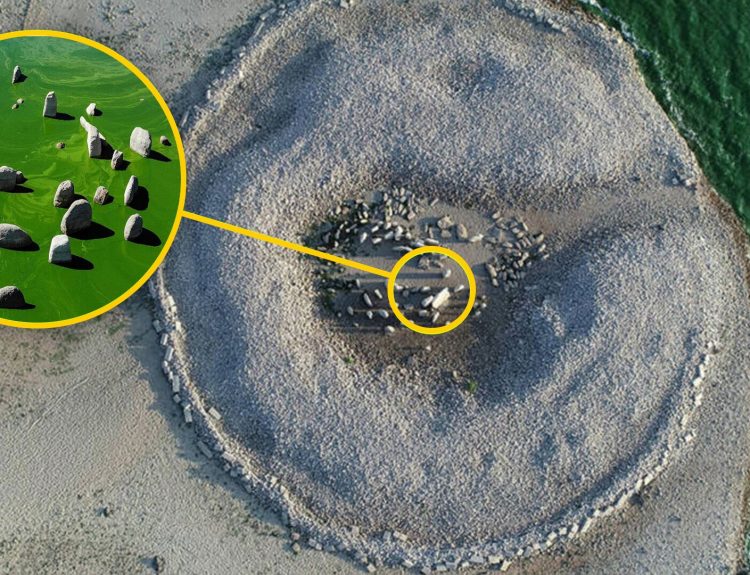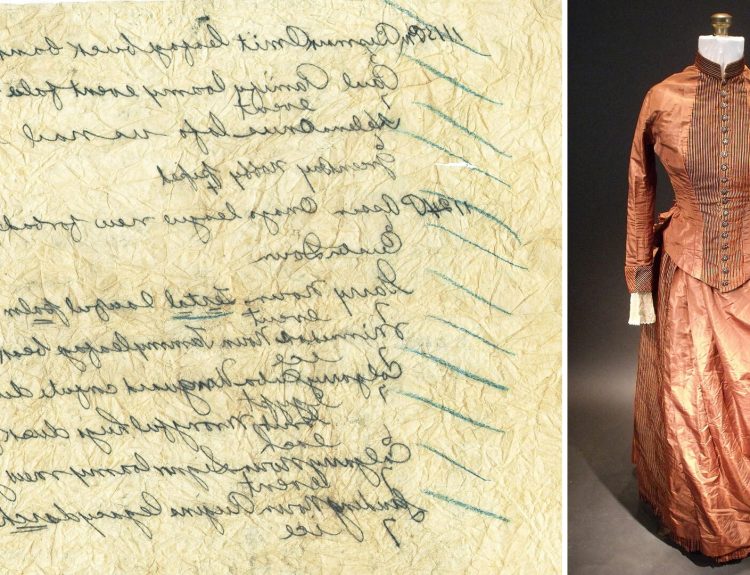We gotta give mad props to the people of the past. Without fancy engineering degrees or state-of-the-art construction equipment, the architects of old were about to build some impressively sturdy structures that have outlasted many modern buildings.
Some were built as homes. Others were religious structures. Some were simply infrastructure. But no matter their purpose, the ancient structures in this collection rank among the oldest man-made buildings that are still in use today.
Lalibela, Ethiopia
Lalibela, located in northern Ethiopia, was constructed in the 12th century. The site, commissioned by King Lalibela, was carved out of solid rock. An impressive eleven medieval churches were chiseled out of basalt, along with catacombs, underground tunnels, and ceremonial chambers.

The important religious site earned the city the nickname “New Jerusalem.” Although Lalibela is now a UNESCO World Heritage site, daily worship services are still held there. Religious pilgrims and tourists flock to Lalibela, especially on holy days like Easter and Christmas.
Nanchan Temple, Shanxi Province, China
One of the oldest Buddhist temples in China, Nanchan Temple, located in Wuxi, Jiangsu Province, China, can trace its history back to the Tang Dynasty. The temple was constructed in 276 AD, during the reign of Emperor Wu of the Western Jin Dynasty and was initially built to spread Buddhism to the region.

Nanchan Temple, the oldest and tallest temple of its kind in the country, holds great cultural and architectural importance to the people of China. Within the temple, there is a vast library of Buddhist texts and other significant religious relics. Would you believe that the five-story wooden pagoda was built without nails?
Ellora Caves, Aurangabad, India
Ellora Caves, located near Aurangabad in the Indian state of Maharashtra, have been used by people of Hindu, Jain, and Buddhist faiths. Work began on the rock-cut temples and monasteries at Ellora Caves in the 6th century and centuries later, the structure was still not complete.

Within the cave complex, there are 34 caves, each serving a different, unique religious function. The first dozen caves feature Buddhist structures, while the 13th to 29th caves are dedicated to Hindu deities. The final four caves are Jain. Cave 16’s Kailasa Temple was carved from a single rock and is of the largest monolithic structures in the world.
Kirkjuboargarour, Kirkjubour, Faroe Islands
Considered the oldest wooden house in the world that is still being occupied, Kirkjuboargarour, was built in the 11th century in Kirkjubour, on the Faroe Islands. According to local legend, the timber used to build the farmhouse came from Norwegian driftwood that washed up on shore.

Kirkjuboargarour has been the residence of members of the Patursson family for more than 17 generations, since 1550. Inside the home is an old wooden chair dating back to the 13th century. As the legend tells us, that chair was a gift from the King of Norway.
Acoma Pueblo, New Mexico, USA
On top of a 367-foot-high in present-day New Mexico, you will find Acoma Pueblo, one of the oldest continuously inhabited communities in North America. Historians believe the pueblo was built around the year 1150, predating the arrival of Europeans to the continent. Because of its lofty location, Acoma Pueblo was nicknamed “Sky City.”
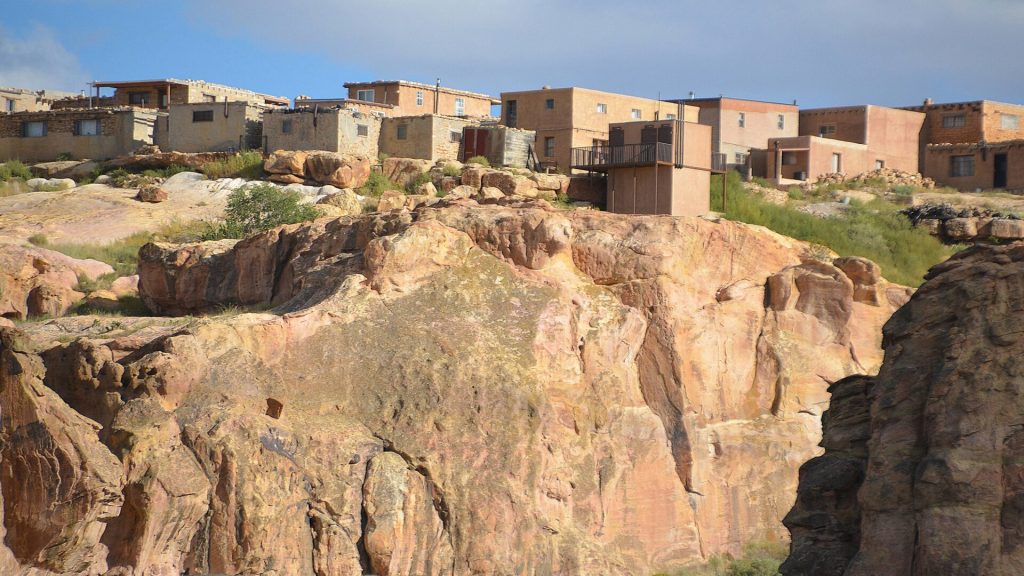
Originally constructed for defensive purposes, the buildings of Acoma Pueblo are made of adobe and sandstone, so they are camouflaged among the natural stone surrounding. surroundings and showcase the architectural ingenuity of the Acoma people. Today, about fifty members of the tribe elders live at Acoma Pueblo year-round.
Church of the Nativity, Bethlehem, Palestine
Emperor Constantine built the Church of the Nativity in Bethlehem in the 4th century, supposedly positioning the church over the actual birthplace of Jesus Christ. For centuries, religious pilgrims have made their way to the Church of the Nativity to pray at the Grotto, marvel at the ornate columns, and view the stunning mosaic tilework.

The Church of the Nativity is an active and functioning church with services held throughout the week. Now a UNESCO World Heritage Site, the church is open to the public.
Shibam, Yemen
The town of Shibam in Yemen has jokingly been compared to Manhattan and Chicago. That’s because the unique buildings in the town, which date back to the 16th century, are multi-storied, high-rises. Some of the homes are up to eleven stories tall … an impressive feat for ancient architects and builders using mudbrick construction.

The town, situated along key trade routes, is still occupied today. In fact, approximately 3,000 people call it home. The buildings are in remarkable condition for their age and the city still serves as an inspiration for urban planners.
Basilica of Constantine, Trier, Germany
Around the year 310, Emperor Constantine ordered the construction of the basilica that would bear his name. The Basilica of Constantine in Trier, Germany, was part of a vast complex of imperial buildings which included a grand palace. The massive hall in the basilica is 220-feet long, 90-feet wide, and has a ceiling height of 108 feet … and it was built without the need for support columns.
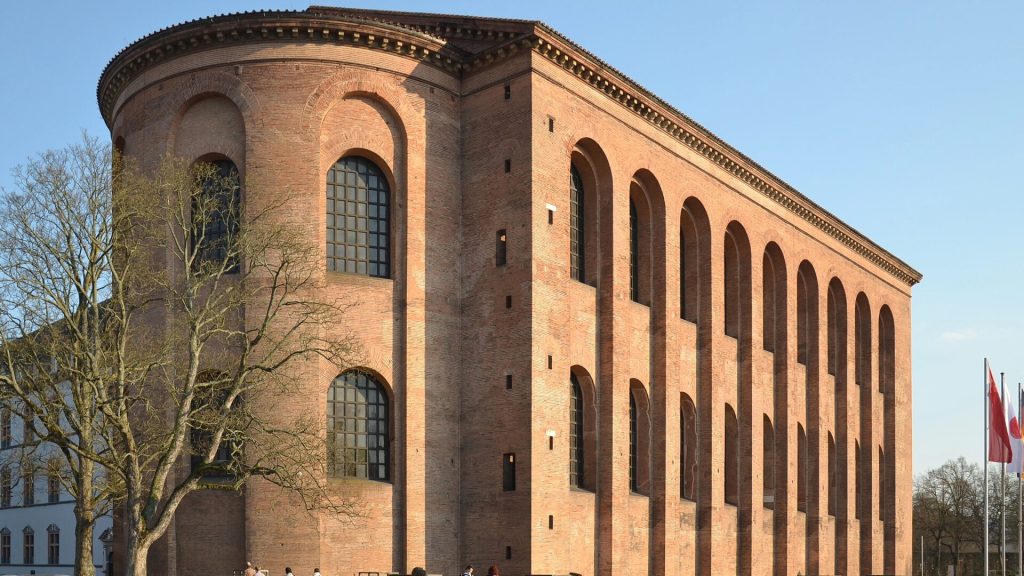
Its function has changed over time. Initially, it was used for official ceremonies and legal proceedings, as well as to host large social gatherings. It was used as a church in the Middle Ages and is still used in that manner today.
Mosque of Uqba, Kairouan, Tunisia
One of the oldest and most culturally significant mosques in the Islamic world, the Mosque of Uqba was built in 670 and named after Uqba ibn Nafi, the founder of Kairouan. When it was built, there were no other places of worship like it. But it set the bar for mosques to follow that adopted its distinctive architectural features.

The Mosque of Uqba was meant to be a true center for worship. It has been used for religious education and meetings. It is still a place of worship today. The doors are open to visitors, however only Muslims are allowed in the prayer room.
St. Catherine’s Monastery, Sinai, Egypt
Built in the 6th century, St. Catherine’s Monastery is one of the oldest continuously operating Christian monasteries in the world. It is located at the foot of Mount Sinai in the Sinai Peninsula, Egypt, and is where Moses received the Ten Commandments from God, according to the Old Testament.

The monastery was named in honor of Saint Catherine of Alexandria. It houses a remarkable collection of religious artifacts, most notably the famous Codex Sinaiticus, one of the earliest known complete manuscripts of the Christian Bible. Still an inhabited Christian monastery, St. Catherine’s Monastery has been designated a UNESCO World Heritage Site.
Tower of Hercules, Galicia, Spain
Built during the reign of Trajan who ruled from the years 98 to 117, the Tower of Hercules in Galicia, Spain, is the only Roman lighthouse still in operation and is believed to be the oldest lighthouse in the world. The navigational aid still guides ships along the Spanish coast.
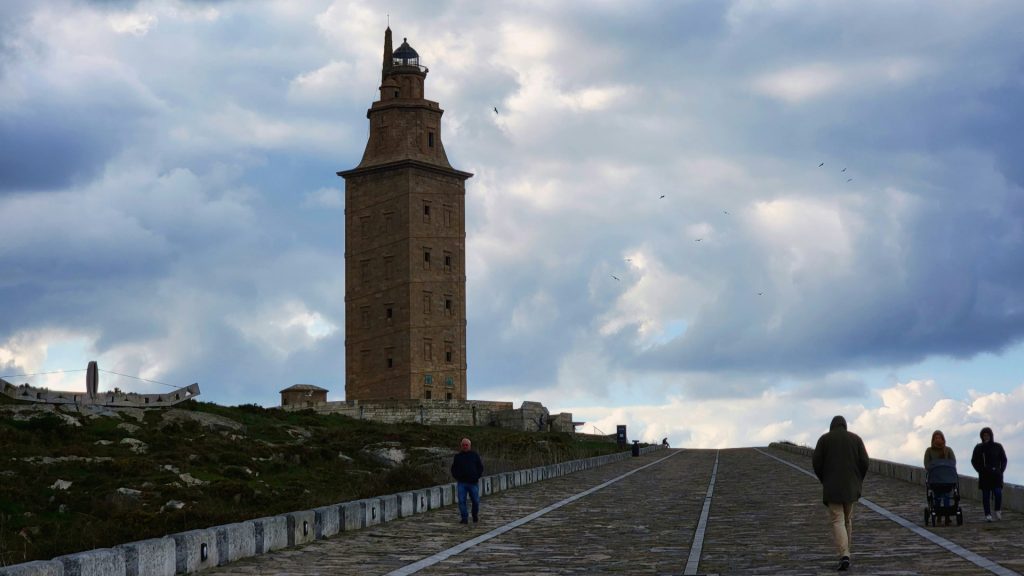
The lighthouse has an interesting four-sided design. At 180-feet tall, it has always been Spain’s tallest lighthouse. It is amazing that the Romans were able to construct such a tall structure and even more amazing that it is still in great condition today.
Hagia Sophia, Istanbul, Turkey
An architectural masterpiece, Istanbul’s Hagia Sophia was originally built as a cathedral by the Byzantine Emperor Justinian I. It was completed in 537 AD and served as the principal church of Eastern Orthodoxy for nearly 1,000 years. In 1453, following the Ottoman conquest of Constantinople, Hagia Sophia was converted into a mosque. For a time starting in 1935, the building served as a museum.
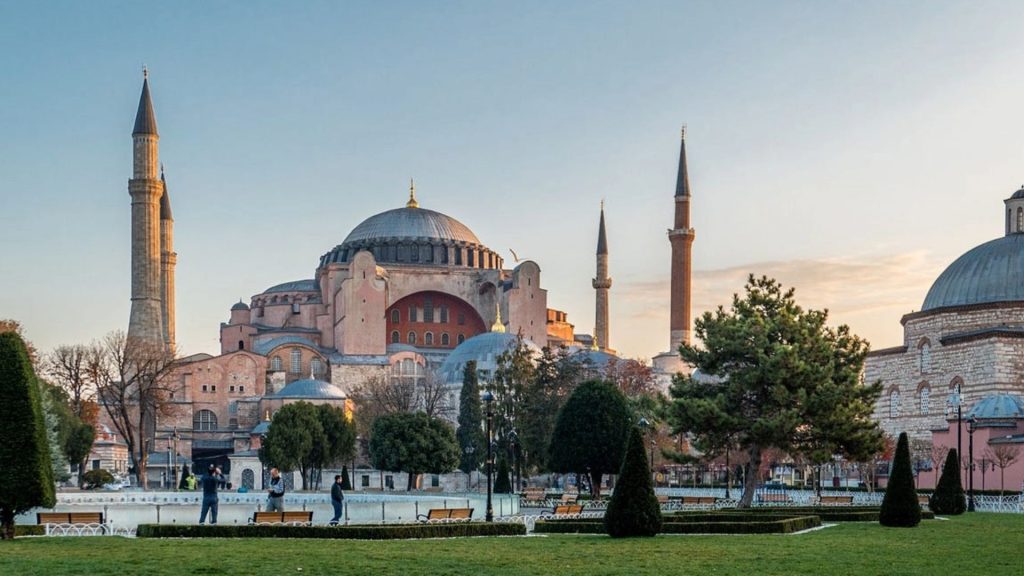
As of 2020, Hagia Sophia reverted back to a mosque. Hagia Sophia is one of Istanbul’s biggest tourist attractions. Its iconic dome, intricate mosaics, distinctive tilework, and awe-inspiring architecture draw tourists from around the world.
Pantheon, Rome, Italy
The twice-destroyed Roman Pantheon is one of Rome’s biggest tourist destinations. The original building was constructed in the 7th century, but two devastating fires brought the building to its foundation. The current structure was commissioned by Emperor Hadrian in the year 125 and used as a Catholic Church.

Visitors to the Pantheon can still attend church services and mass while they admire the architectural marvels of the building. The rotunda and grand columns are stunning, but it is the dome’s oculus skylight that is the main attraction.
Proserpina Dam, Extremadura, Spain
The Proserpina Dam was designed and constructed around the year 100 when the Romans ruled the region. It was one of their most ambitious projects of their extensive aqueduct programs. The Proserpina Dam created a reservoir that supplied water for human consumption, livestock and farm fields, and the public baths of Merida, Spain.
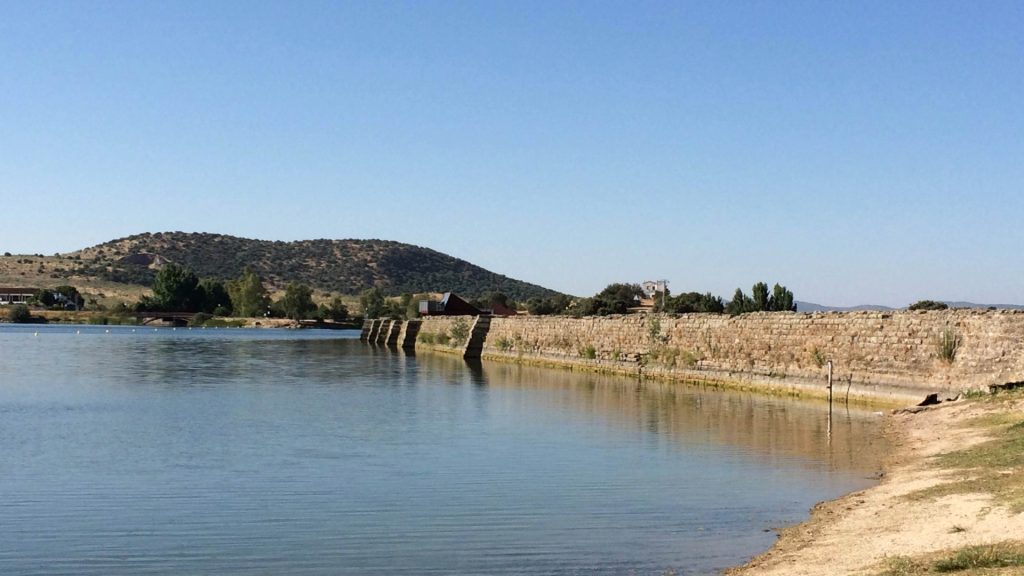
The dam is still standing strong, a testament to the construction and engineering skills of the ancient Romans. A fun fact about the dam is that it was called Albuera de Carija for most of its existence until an ancient inscription was found bearing the name of the Roman goddess of the underworld, Proserpina.
Santa Sabina, Rome, Italy
Santa Sabina, located on Rome’s Aventine Hill, is one of the world’s oldest surviving Roman basilicas. It was built in the year 432 under Pope Sixtus III. The structure has been well preserved and maintained, including the intricately carved wooden doors which feature biblical scenes.
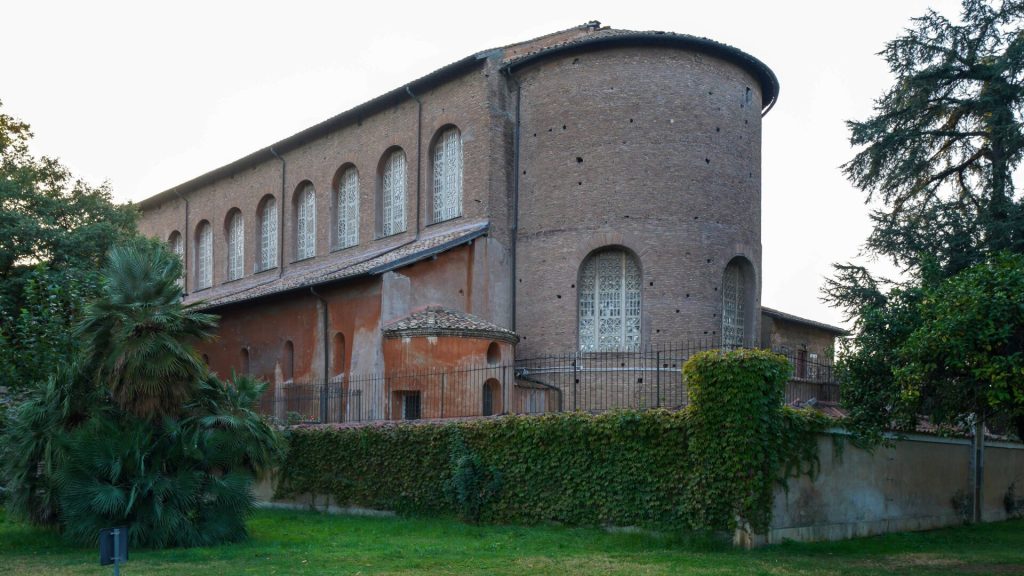
Other notable architectural features include the Corinthian colonnades, mosaic tile work, and the selenite windows. It is not just an historic building, but it is a beloved place of worship in Rome.
Sanchi Stupa, India
Sanchi Stupa is an important Buddhist monument located in Madhya Pradesh, India. As one of the oldest stone structures in India, the stupa was built by Emperor Ashoka in the 3rd century BCE, with a sizable addition built in the 1st century BCE.

The stupa was constructed to house Buddhist relics. It became an important pilgrimage for Buddhist travelers. It fell into disrepair and sat unused for six centuries until it was restored in the 1900s. Today, it once again attracts Buddhist pilgrims.
Caravan Bridge, Izmir, Turkey
The Guinness Book of World Records lists Caravan Bridge in Turkey as the oldest bridge in the world that is still being used. It was built over the Nilufer River on the Silk Road route, connecting Bursa to Istanbul, by Sultan Murad II. Completed in 1442, the bridge facilitated trade between Europe and Asia.
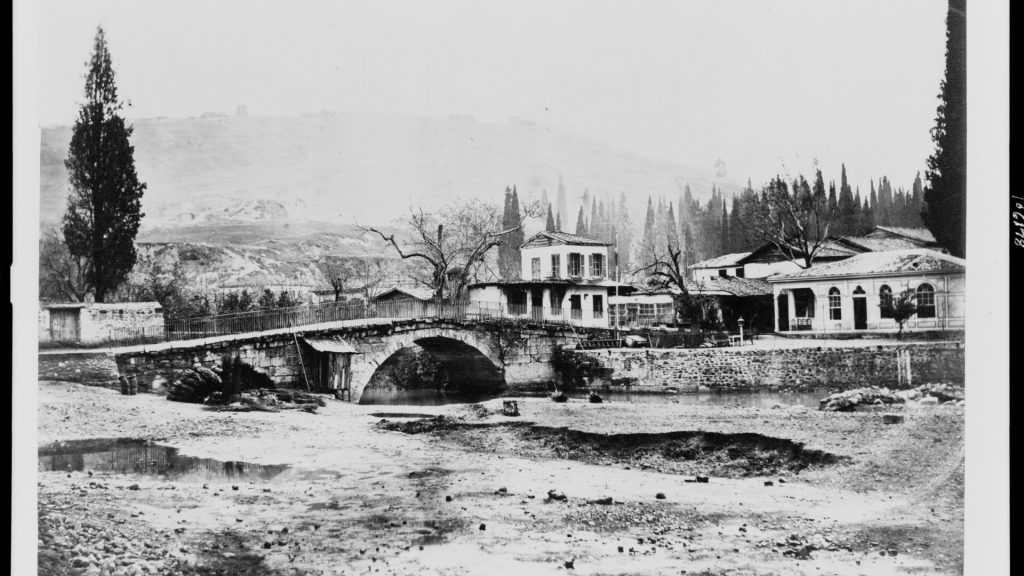
The bridge builders used locally quarried stones in the construction project. The design is simple, yet effective, which is why the Caravan Bridge has stood strong for so long.
Arles Amphitheater, Provence, France
Arles Amphitheater, which is reminiscent of the Roman Colosseum, is the largest Roman monument in France. The theater was built between the years 80 and 90 as a venue for chariot races and other gladiator battles. A massive structure with more than one hundred arches and two tiers of spectator seats, the amphitheater can hold up to 20,000 audience members.
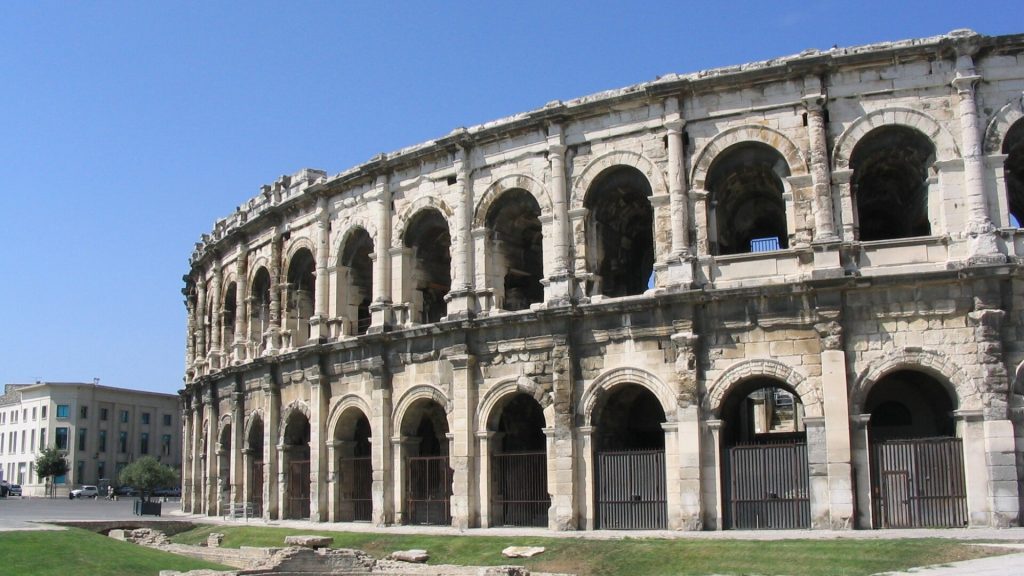
There are no Ben-Hur-inspired chariot races held at Arles Amphitheater these days. It has hosted bullfighting events, concerts, and theatrical performances since the 1900s.
Ponte Fabricio, Rome, Italy
The Ponte Fabricio, the oldest bridge in Rome, is a pedestrian bridge that looks almost unchanged since it was completed in the year 62. The bridge, which was built to replace an older wooden bridge that was damaged by fire, connects Tiber Island to the mainland of Rome.

The structure is 200 feet long. It was so well built that it required only minimal maintenance.
Van Fortress, Van, Turkey
Van Fortress was initially built in the 9th century BCE by the Urartian King Sarduri II to protect the city of Van in eastern Turkey. The fortress has gone through numerous expansions under different rulers, including the Armenian, Byzantine, and Ottoman kings. Building the fortress required the engineers to use advanced mathematical techniques and stone cutting methods.

For many years, Van Fortress was a symbol of power or strength. It served as a military stronghold, royal palace, and a place of worship. The Armenian Church of Akdamar lies within the walls of the fortress.
Mausoleum of Hadrian, Rome, Italy
As the name suggests, the Mausoleum of Hadrian, which was built in the year 139, serves as the tomb of Emperor Hadrian. Several of his family members and even a few of his successors are also interred there.

The impressive building, which boasts a cylindrical edifice, was also used as a fort, a prison, and even a papal residence. It is a museum these days and visitors are welcome to admire the architecture and artifacts housed there.
Mundeshwari Temple, Bihar, India
One of the oldest Hindu temples in the world is also one of the most beautiful. The Mundeshwari Temple dates back to the year 105 and is dedicated to Shiva and Shakti. The octagonal shape of the stone building makes it distinctive.
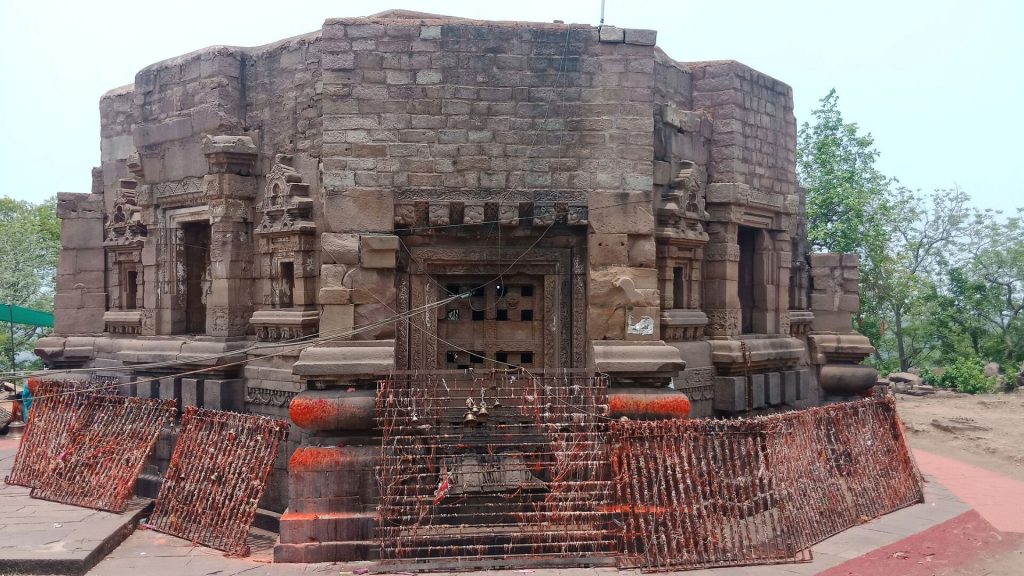
Located on the Mundeshwari Hills, the temple still attracts worshippers. It hosts huge crowds during the Rama Navami and Shivratri festivals.
Theater of Marcellus, Rome, Italy
The Romans built the Theater of Marcellus in the year 13 BC to be the Roman Empire’s largest theater. More than 40,000 spectators could attend the music, theatrical, and dance performances. A striking structure, the theater was made using brick and concrete and covered with limestone travertine.

The Theater of Marcellus is huge and historic. It still hosts classical concerts under the stars in the summertime, however the upper floors of the building have been converted into luxury apartments.
Stonehenge, Wiltshire, England
The magical and mystical Stonehenge, found on England’s Salisbury Plain, was most likely built around 2500 BC. Although we don’t know exactly how or why, we do know that the stones were quarried from far-off Wales.

This mysterious prehistoric continues to baffle historians even as it is venerated by pagans and druids. They, along with thousands of tourists, regularly visit Stonehenge. It is during the winter and summer solstices, however, when Stonehenge really shines. Folks flock to Stonehenge to witness the astronomical alignments.





